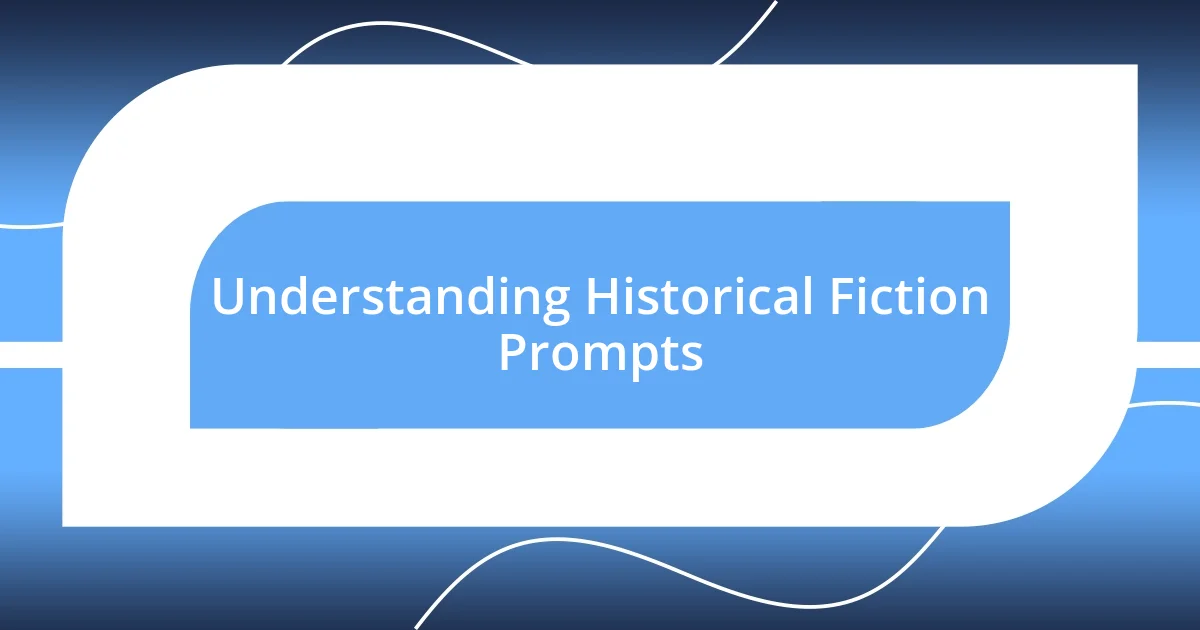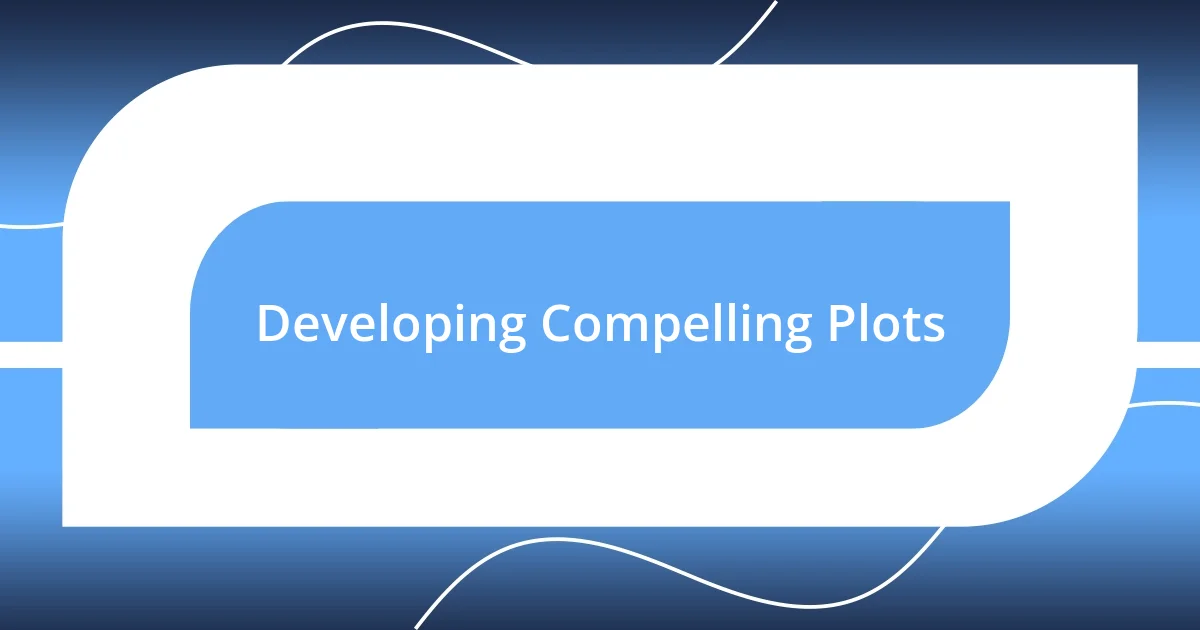Key takeaways:
- Historical fiction prompts invite writers to explore human experiences behind historical events, enhancing the understanding of both history and fiction.
- Setting context is crucial, enriching narratives by grounding them in specific times and circumstances, allowing readers to connect emotionally with characters and their struggles.
- Incorporating real events and crafting authentic dialogue can deepen the narrative’s authenticity and enhance reader engagement through relatable character experiences and interactions.

Understanding Historical Fiction Prompts
Understanding historical fiction prompts can feel like peeling back layers of time. When I first encountered a prompt themed around World War II, I wasn’t just writing about events; I was stepping into the shoes of those who lived through it. That immersive experience made me wonder: how do these prompts challenge our understanding of history versus fiction?
Each prompt invites a unique exploration of a specific era, urging us to consider the human experiences behind historical facts. I remember tackling one about the Renaissance, and it struck me how it wasn’t merely about famous artists or inventions; it was also about the struggles and dreams of ordinary people during that transformative period. Isn’t it fascinating how these stories can reshape our perception of history?
Moreover, a well-crafted prompt can evoke strong emotional responses. When I worked on a piece centered around the Civil Rights Movement, the weight of the characters’ struggles made the past feel alive and relevant. It brings to mind a question: how does our understanding of the past shape our perspectives today? Embracing these prompts isn’t just about writing; it’s about engaging in a dialogue with history itself.

The Importance of Setting Context
Setting context in historical fiction is crucial. It gives depth to the narratives we craft and invites readers to feel the weight of time and circumstance. I recall diving into a prompt set during the Great Depression. The stark realities of that era were not just statistics for me; they became visceral. I felt the chill of a bleak winter and the pervasive uncertainty that many faced. It underscores the importance of grounding our stories in specific times and places.
- Context establishes the emotional landscape of the narrative.
- It helps readers connect with historical events through personal experiences.
- Precise settings can amplify the gravity of the plot, making characters’ struggles more relatable.
- It enriches the storytelling by providing a framework of cultural, social, and political influences.
- The right context fosters a deeper understanding of human resilience in the face of adversity.

Crafting Relatable Characters
Crafting relatable characters in historical fiction is essential to connect emotionally with readers. When I created a character set in the Victorian era, I made sure they faced struggles that resonate today, like societal expectations and personal ambitions. It’s these relatable dilemmas that draw readers in, making them feel as if they’re experiencing the character’s journey alongside them.
As I developed a character who lived during the Industrial Revolution, I delved into their everyday life: the noise of machinery, the dust-filled air, and the hope for better conditions. I found myself reflecting on how these sensory details brought this character to life. Readers can often see themselves in these human struggles, and that’s what helps historical fiction thrive.
To deepen that relatability, I also believe in giving characters flaws and complexities. While writing a character from the French Revolution, I showed their internal conflict between loyalty to friends and the pursuit of justice. It’s crucial that readers feel both the strength and vulnerability of these characters, creating a bridge between their world and our own.
| Characteristics | Examples |
|---|---|
| Emotional Struggles | Facing societal pressures in Victorian times |
| Sensory Details | Describing the noise and conditions of the Industrial Revolution |
| Flaws and Complexities | Internal conflicts during the French Revolution |

Developing Compelling Plots
When I think about developing compelling plots in historical fiction, I often find that weaving in real events can elevate the narrative significantly. For example, while delving into the aftermath of World War I, I created a storyline around a family struggling to rebuild their lives. It was fascinating to explore how the war had irreversibly changed their dynamics, pushing them toward choices they would never have made otherwise. Would they cling to the remnants of their past, or embrace a new reality? That tension kept me—and hopefully the readers—engaged.
Pacing is another crucial element for me. I learned from writing a story set during the Harlem Renaissance that carefully balancing moments of tension with quieter reflectiveness can keep readers invested. The characters needed to navigate the vibrant cultural backdrop while also confronting their personal challenges, which created a natural ebb and flow. I remember how rewarding it was to craft those shifts—one moment, the energy was palpable in a jazz club, and the next, the protagonist was alone, grappling with the weight of aspiration and heartache.
Furthermore, I believe the stakes in historical fiction should reflect the true turmoil of the times. When I crafted a plot around the suffragette movement, I wanted each decision to carry the weight of significant consequences. Should a character risk everything for their beliefs, or protect their family instead? These dilemmas resonate deeply, and presenting them authentically can transform a plot from simply being a sequence of events into a gripping exploration of human resilience. Isn’t that what we seek in great storytelling—the moments that mirror our own struggles and triumphs?

Incorporating Real Events Effectively
Incorporating real events into historical fiction can breathe authenticity into my storytelling. When I wrote about the fall of the Berlin Wall, I explored how the characters’ lived experiences were shaped by the tension and hope surrounding that pivotal moment. I remember the energy in the air as people dreamed of freedom and unity, and I made sure those emotions were palpable on the page. How can one resist the pull of such monumental shifts in reality?
In another project centered around the Civil Rights Movement, I intertwined actual protests with my characters’ personal narratives. It was essential for me to depict not only the public actions but also the private fears and triumphs that accompanied such an intense struggle for justice. I often found myself reflecting on how that era’s fight is echoed in today’s ongoing conversations about equality. Isn’t it powerful when the past informs our present and compels us to reflect on our own roles in such movements?
Effectively weaving real events into my plots also requires a thoughtful approach to character interactions. I recall writing a scene where my characters learned about the outcomes of historical events that directly impacted their lives. Their reactions—ranging from despair to hope—encouraged my readers to engage with history on a deeper level. Readers often appreciate those moments of revelation. After all, how can we truly understand the past if we don’t feel its impact in our characters’ hearts?

Tips for Authentic Dialogue
For me, crafting authentic dialogue in historical fiction often means considering the nuances of language from the era I’m writing about. I remember when I characterized a Victorian-era family; their speech patterns were intricate, almost rhythmic, filled with formality and unspoken rules. Hearing the characters speak in ways that reflect their time not only adds depth but offers readers an immersive experience. Ever tried to interpret a letter from that period? It’s amazing how a single phrase can reveal cultural values and social norms.
I also pay close attention to regional dialects and slang. When I wrote about characters from the Appalachian region during the Great Depression, I immersed myself in their unique expressions. It was astonishing how a simple “y’all” could convey familiarity and warmth. It made me think: How many subtleties do we overlook when we default to generic dialogue? I believe well-researched language choices can transport readers straight into the heart of the narrative, making the story feel alive.
Humor can also be a powerful tool in dialogues, despite the weight of historical settings. I once wrote a scene in which two soldiers exchanged banter while waiting for reinforcements during World War II. Their playful jabs lightened a desperate moment, reminding me how humor can be a lifeline even in dire circumstances. How often do we rely on laughter to forge connections? By weaving humor into historical conversations, I found that it not only humanizes the characters but also resonates with readers on a fundamentally relatable level.

Examples of Engaging Prompts
One engaging prompt I often consider is, “Write about a pivotal moment in history through the eyes of a bystander.” This approach taps into the idea that not everyone directly involved in historical events perceives them the same way. I recall crafting a narrative from the perspective of a street vendor during a great revolution. By focusing on her observations and emotions, I was able to portray the chaos and excitement of the time—addressing how daily life is inexorably tied to the storm of history.
Another powerful prompt I enjoy is, “Imagine a love story set against the backdrop of a historical event.” I once explored the tragic romance between two individuals from opposing sides during a significant war. Their secret meetings brought depth to an otherwise brutal setting, allowing me to delve into themes of loyalty and sacrifice. Have you ever wondered how personal connections can flourish in the most challenging circumstances? This prompt surely provides rich ground for exploring the resilience of the human spirit.
Finally, consider a prompt like, “Rewrite a well-known historical event from a completely different perspective.” This has allowed me to rethink the narratives we often take for granted. For instance, I reimagined a famous battle as seen through the eyes of the camp’s cook. His experiences reflected the mundane yet essential aspects of wartime life, highlighting how even those in the background contribute to history. Isn’t it fascinating how perspective can transform our understanding of the past? These examples show just how versatile and thought-provoking historical fiction prompts can be.













